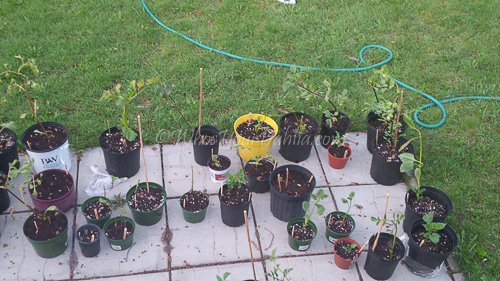Don’t let your hard work be for naught by putting your plant outside too soon and for too long. I know how easy it is to get over excited about the idea of finally having them outside.
Just think of a fish. When you buy a new fish for your aquarium, you must first place the bag, with the fish ![]() , in the aquarium for a while before you put it in it’s new home. The fish has to be acclimatize to its new home.
, in the aquarium for a while before you put it in it’s new home. The fish has to be acclimatize to its new home.
It’s the same for introducing indoor plants to the great outdoors! Even though your intent is to plant them outdoors, since there were started indoors, it is an indoor plant.
Plants grown indoors are protected. They live in a controlled environment where there isn’t usually any major changes. As a result they will have to adapt before being placed outside permanently.
Outdoors plants endure both heat and cold. They bend with the wind (sometimes too much #HowMyDahliaBroke) and welcome the rain drops (when it’s not too heavy :)).
The hardening process is a mandatory step for plants that are started indoors.
It introduces your indoor plants to the more extreme weather outdoors. Hardening your plants reduces the risk of transplant shock, which can kill plants. The gradual introduction also prepares your plants for direct sunlight, this will prevent them from burning when left outside.

Hardening is a gradual process. Here are some definite don’ts
- Don’t start it on a an extremely hot day. Indoor plants can burn in minutes.
- Don’t start until the treat of frost is gone.
- Don’t leave outside if the temperature is expected to fall below 10
Before putting your plants outside, here are a few things you can do.
- Place them near an open window, this will expose them to an airflow and direct sunlight
- Fertilize less and reduce watering.
- Water only when the soil feels dry to the touch.
Start with leaving your plants outside for one to two hours. it’s best to do this on an overcast day, this reduces they’re exposure to too much sunlight to fast. Or somewhere where they are not getting too much direct sunlight. Increase by one hour each subsequent day until eventually the plants are outside all day.
Bring plants in at night or if there is a treat of extreme weather. After about 10 days your plants are ready for transplanting and soon you’ll be enjoying their the fruits and vegetables of your labour, not to mention their beautiful blooms and fragrances.
So go forth and plantify! 😉
Whos Your Dahlia – It’s About Bloomin’ Time!
You don’t need a yard to reap the benefit from gardening. All it takes is one pot and one plant. It usually ends up leading to more but I won’t judge 😀 .
Read more about the benefits of gardening to your mental health!
Some more blooming information!
Start Dahlias Indoors Dahlias in Containers


Butterfly Kisses What’s The Buzz




